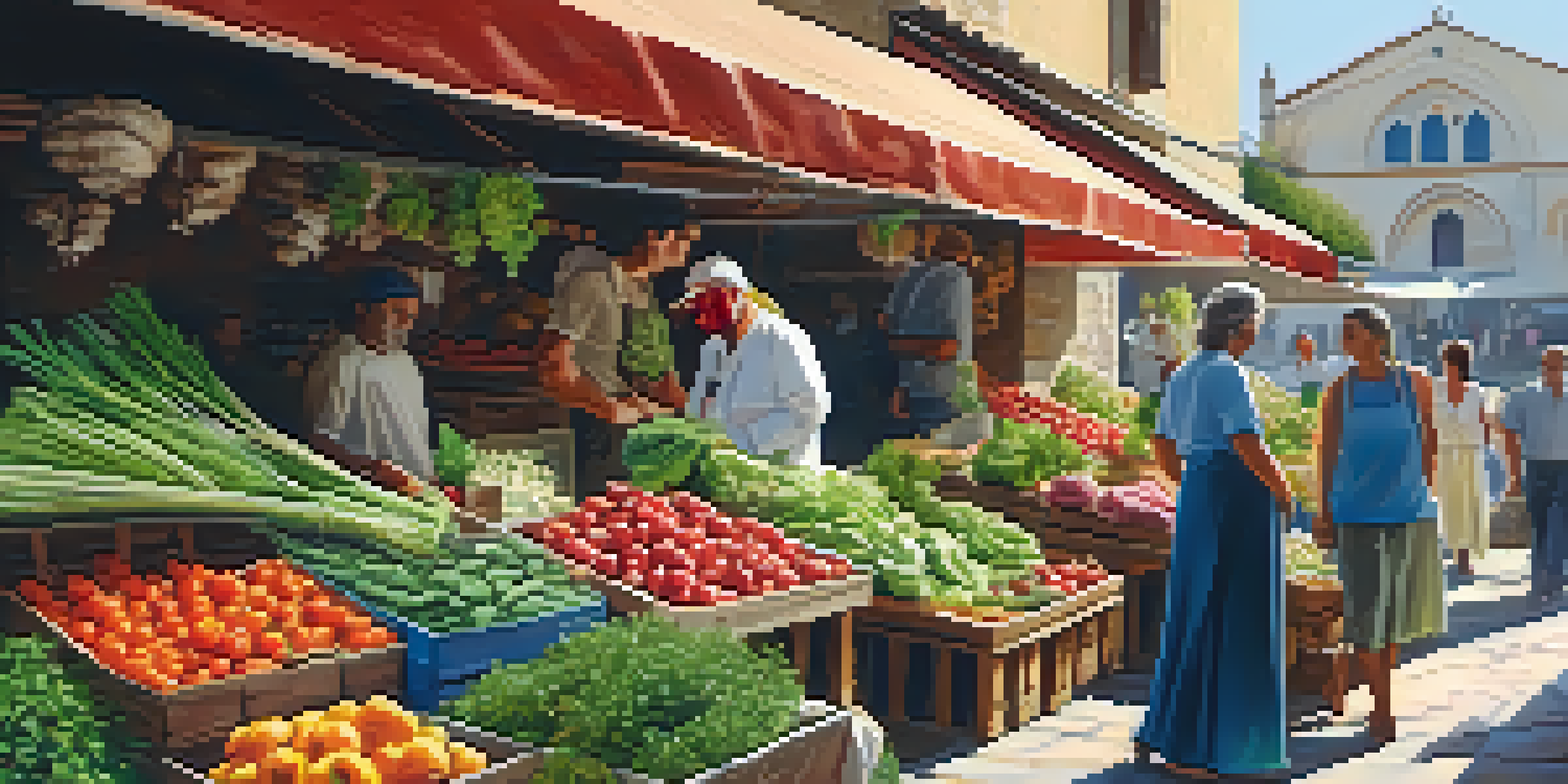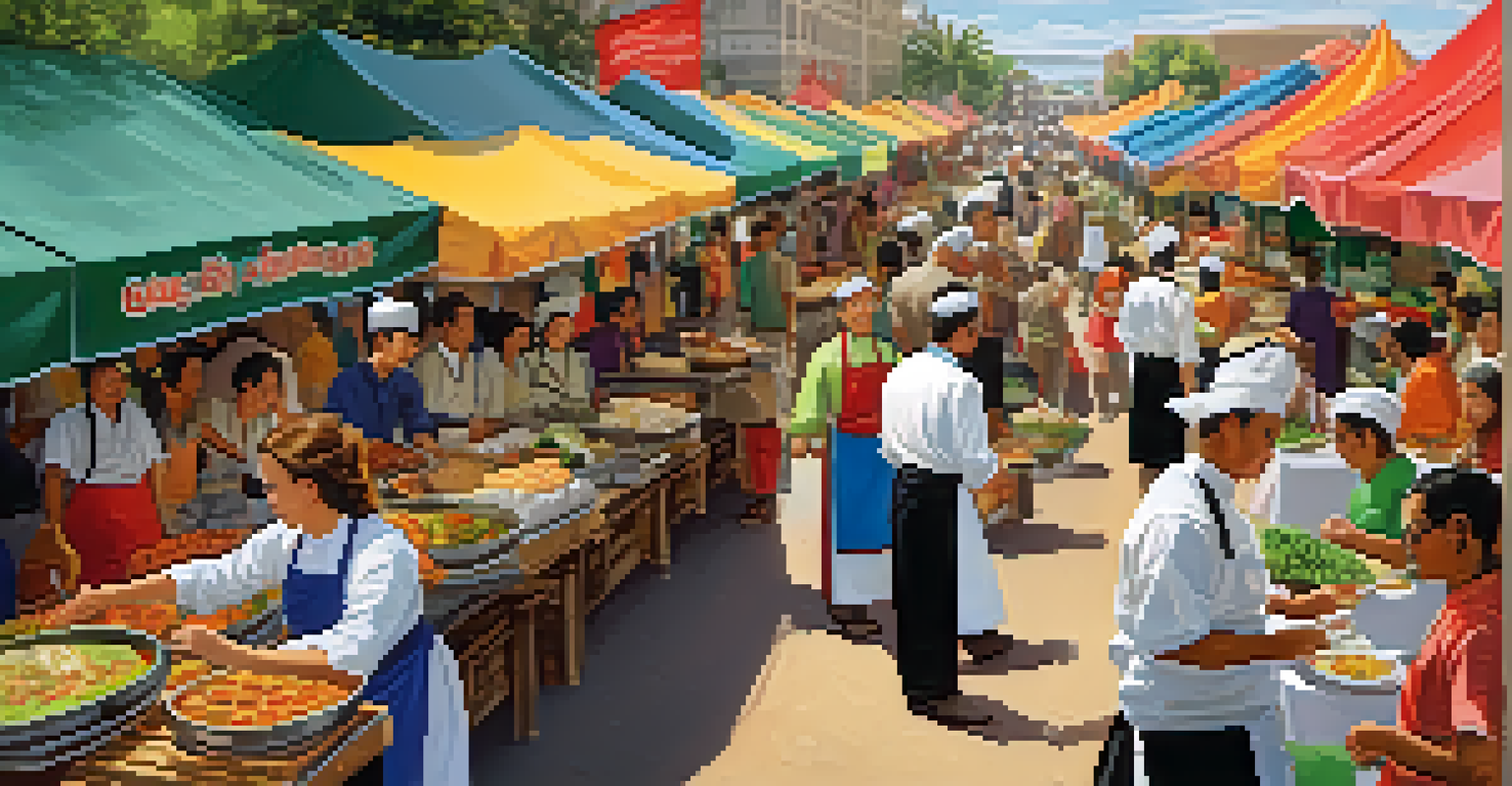Culinary Heritage: Understanding Traditional Cooking Techniques

What is Culinary Heritage and Why Does It Matter?
Culinary heritage encompasses the traditional practices and recipes passed down through generations. It's not just about food; it's a reflection of culture, history, and the identity of a community. Understanding culinary heritage helps us appreciate the flavors and techniques that shape local cuisines worldwide.
Food is an important part of a balanced diet.
When we talk about culinary heritage, we're diving into a treasure trove of knowledge and storytelling. Each dish tells a story—whether it's a family recipe prepared during holidays or a community feast that celebrates local ingredients. By preserving these traditions, we honor our ancestors and keep their legacies alive.
Moreover, culinary heritage plays a crucial role in sustainability. Traditional cooking techniques often emphasize the use of local, seasonal ingredients, which can reduce our carbon footprint and promote biodiversity. Embracing these practices today can lead to a healthier planet and a richer culinary experience.
Key Traditional Cooking Techniques to Explore
Traditional cooking techniques vary widely across cultures, each with its unique methods and tools. For instance, the art of fermentation can be seen in many cuisines, from kimchi in Korea to sauerkraut in Germany. These techniques not only enhance flavors but also offer health benefits, like improved digestion.

Another cornerstone of traditional cooking is smoking, used in various cultures to preserve meats and fish. The rich, smoky flavor adds depth to dishes, making them memorable. Think of smoked salmon or barbecue ribs; these techniques elevate basic ingredients into something extraordinary.
Importance of Culinary Heritage
Culinary heritage reflects culture and identity, preserving traditional practices and recipes that connect us to our history.
Lastly, techniques like slow cooking or braising allow flavors to meld beautifully, creating comforting dishes. Whether it's a hearty stew or a delicate sauce, these methods remind us of the joy of cooking with patience and care, resulting in meals that nourish both body and soul.
The Role of Local Ingredients in Traditional Cooking
Local ingredients are at the heart of traditional cooking techniques. They not only provide unique flavors but also reflect the region's climate and culture. Using what's available locally fosters a connection between the cook and their environment, making each dish a celebration of place.
Cooking is like love. It should be entered into with abandon or not at all.
For example, in Mediterranean cuisine, fresh herbs like basil and oregano are essential. These herbs thrive in the warm climate and are used to create vibrant flavors in dishes like pesto and ratatouille. By using local produce, chefs can create authentic dishes that resonate with their culinary roots.
Moreover, prioritizing local ingredients supports local farmers and promotes sustainable agriculture. When we choose to cook with what's in season, we not only enjoy fresher produce but also contribute to the local economy. It's a win-win for our palates and our communities.
Preserving Culinary Heritage for Future Generations
As global influences continue to shape our diets, preserving culinary heritage becomes increasingly vital. Teaching younger generations about traditional cooking methods can instill a sense of pride and appreciation for their cultural backgrounds. It's about more than cooking; it's about passing down stories and traditions.
Community workshops, cooking classes, and food festivals can play a significant role in this preservation. These events allow individuals to engage with their culinary heritage actively, learn from elders, and even experiment with traditional recipes. It's a beautiful way to keep the spirit of traditional cooking alive.
Role of Local Ingredients
Using local ingredients in traditional cooking fosters a connection to the environment and supports sustainable agriculture.
Additionally, documenting recipes and techniques through books, blogs, and videos can help safeguard this knowledge. By sharing these resources online, we ensure that culinary heritage is accessible to anyone interested, fostering a broader appreciation for diverse food cultures.
The Impact of Globalization on Traditional Cooking
Globalization has undeniably influenced our food landscape, introducing new ingredients and techniques from around the world. While this can lead to exciting culinary fusions, it also poses a risk to traditional cooking practices. Many time-honored recipes and methods are at risk of being forgotten amid the fast-paced food industry.
For instance, the rise of fast food has shifted many people's eating habits away from traditional meals. This shift can dilute the importance of local cuisines and the stories behind them. However, some chefs are working to revive these traditions by incorporating them into modern culinary practices, striking a balance between old and new.
Ultimately, it's essential to celebrate both traditional and contemporary cooking. By doing so, we create a diverse culinary landscape that honors the past while embracing innovation. This balance can lead to a richer food culture that respects heritage while allowing for creativity.
Celebrating Culinary Heritage Through Festivals and Events
Food festivals and events serve as fantastic platforms for celebrating culinary heritage. These gatherings not only showcase traditional dishes but also bring communities together to share their stories and customs. Imagine a festival dedicated to regional cuisine, where visitors can sample local specialties and learn about the cooking techniques behind them.
Such events often feature cooking demonstrations by skilled chefs and home cooks alike. These demonstrations provide a hands-on experience, allowing attendees to see traditional techniques in action and even try their hand at cooking. It's an engaging way to appreciate the artistry involved in traditional culinary practices.
Globalization's Impact on Cooking
While globalization introduces new culinary influences, it also risks overshadowing traditional cooking practices and recipes.
Moreover, festivals can help preserve culinary heritage by promoting local ingredients and sustainable practices. By encouraging attendees to support local farmers and artisans, these events foster a sense of community and appreciation for the food we consume. In this way, culinary heritage becomes not just a relic of the past but a living, evolving part of our culture.
How to Incorporate Traditional Techniques in Modern Cooking
Incorporating traditional cooking techniques into modern kitchens can enhance your culinary repertoire. Start by exploring simple methods, such as fermentation or pickling, to add depth and flavor to your dishes. These techniques can elevate everyday meals, turning them into something special.
Experimenting with slow cooking methods, like braising or stewing, can also yield delicious results. Imagine a modern twist on a classic dish, such as a slow-cooked chili that incorporates regional spices or herbs. This blend of tradition and innovation allows you to create meals that tell a story while satisfying contemporary tastes.

Finally, don't shy away from seeking inspiration from traditional cuisines around the world. Whether it's a family recipe or a dish from a different culture, embracing these techniques can lead to a richer cooking experience. You're not just preparing food; you're connecting with history and enjoying the journey of flavors that span generations.